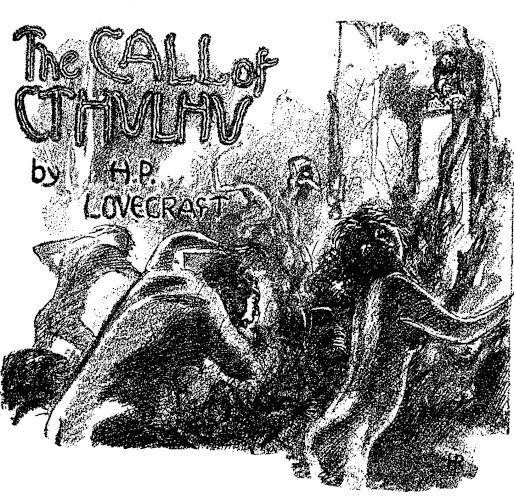The CALL of CTHULHU
By H.P. LOVECRAFT
[Transcriber's Note: This etext was produced from
Weird Tales, February 1928.
Extensive research did not uncover any evidence that
the U.S. copyright on this publication was renewed.]
"Of such great powers or beings there may be conceivably a survival... a survival of a hugely remote period when ... consciousness wasmanifested, perhaps, in shapes and forms long since withdrawn beforethe tide of advancing humanity ... forms of which poetry and legendalone have caught a flying memory and called them gods, monsters,mythical beings of all sorts and kinds...."
—Algernon Blackwood.

"The ring of worshipers moved in endless bacchanalebetween the ring of bodies and the ring of fire."[1]
1. The Horror in Clay.
The most merciful thing in the world, I think, is the inability of thehuman mind to correlate all its contents. We live on a placid islandof ignorance in the midst of black seas of infinity, and it was notmeant that we should voyage far. The sciences, each straining in itsown direction, have hitherto harmed us little; but some day the piecingtogether of dissociated knowledge will open up such terrifying vistasof reality, and of our frightful position therein, that we shall eithergo mad from the revelation or flee from the deadly light into the peaceand safety of a new dark age.
Theosophists have guessed at the awesome grandeur of the cosmic cyclewherein our world and human race form transient incidents. They havehinted at strange survivals in terms which would freeze the blood ifnot masked by a bland optimism. But it is not from them that therecame the single glimpse of forbidden eons which chills me when I thinkof it and maddens me when I dream of it. That glimpse, like all dreadglimpses of truth, flashed out from an accidental piecing together ofseparated things—in this case an old newspaper item and the notes ofa dead professor. I hope that no one else will accomplish this piecingout; certainly, if I live, I shall never knowingly supply a link inso hideous a chain. I think that the professor, too, intended to keepsilent regarding the part he knew, and that he would have destroyed hisnotes had not sudden death seized him.
My knowledge of the thing began in the winter of 1926-27 with the deathof my grand-uncle, George Gammell Angell, Professor Emeritus of Semiticlanguages in Brown University, Providence, Rhode Island. ProfessorAngell was widely known as an authority on ancient inscriptions, andhad frequently been resorted to by the heads of prominent museums; sothat his passing at the age of ninety-two may be recalled by many.Locally, interest was intensified by the obscurity of the cause ofdeath. The professor had been stricken whilst returning from theNewport boat; falling suddenly, as witnesses said, after having beenjostled by a nautical-looking negro who had come from one of the queerdark courts on the precipitous hillside which formed a short cut fromthe waterfront to the deceased's home in Williams Street. Physicianswere unable to find any visible disorder, but concluded after perplexeddebate that some obscure lesion of the heart, induced by the briskascent of so steep a hill by so elderly a man, was responsible forthe end. At the time I saw no reason to dissent from this dictum, butlatt